MARCH 17, 2011 — I’m sitting at a gate in the Casablanca airport for a flight to Cairo, and I start to feel nervous. Almost all of the passengers I see are wearing thawbs (long white robes) and keffiyehs (traditional Arab headdresses). I’m one of the few people wearing Western clothing, and I’m the only white guy at the gate. The conservatively-dressed passengers only increase my anxiety that my friend Quinn and I will stand out like yachts off the Somalian Coast while we travel in a country amidst revolution; after all, I am a blue-eyed, six-foot-tall guy, and Quinn is a girl with long, wavy blond hair and green eyes.
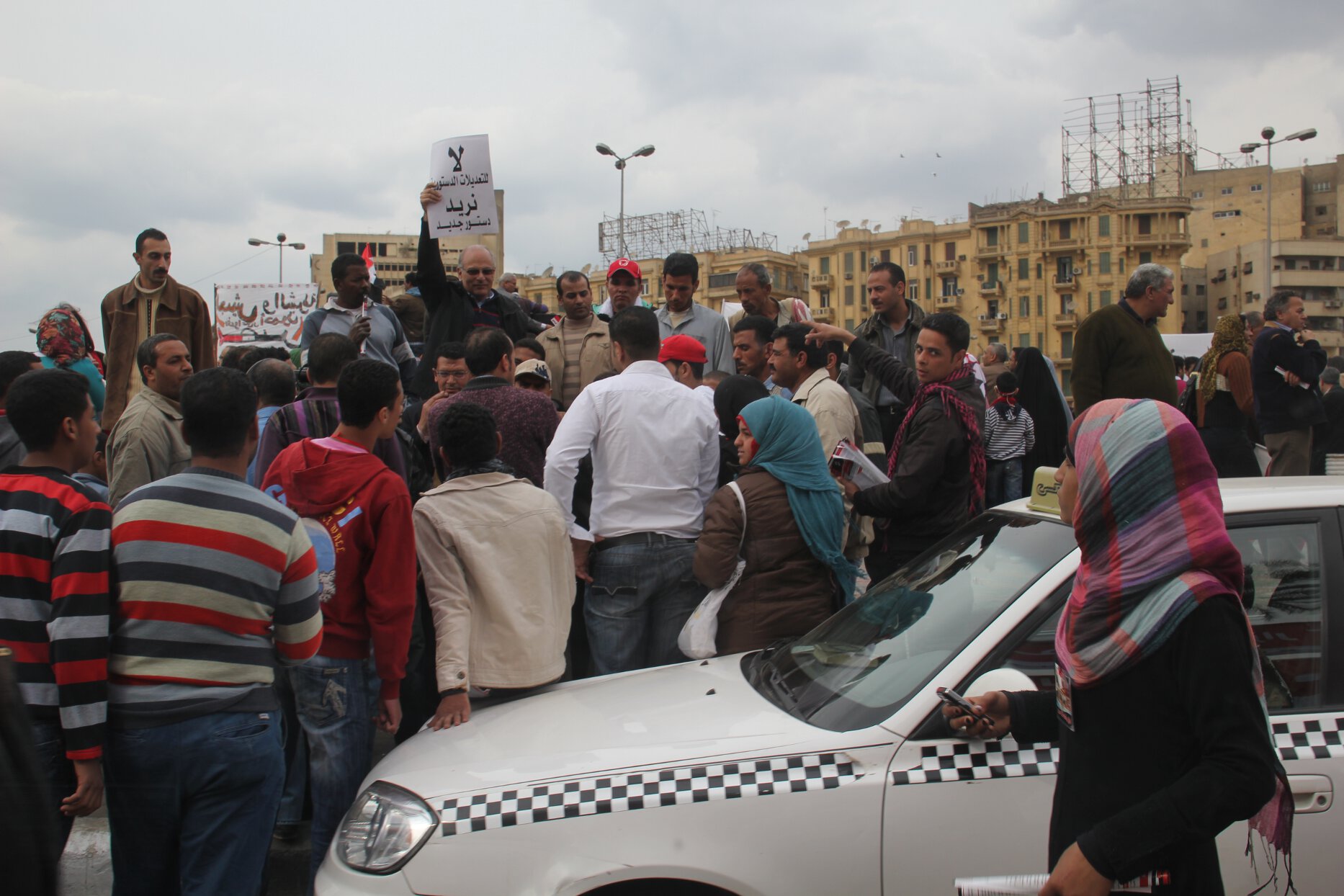
Protesters gather on a Friday in Cairo’s Tahrir Square.
When I was offered a job in January requiring travel to Morocco, I thought to e-mail Quinn immediately. I had always wanted to visit Egypt, and since she was already working in Africa, I suspected that she might be willing to meet me in Cairo for a couple weeks before the start of my job.
But, as is well known by now, on January 25, 2011, millions of protestors, organizing themselves using Facebook, Twitter, and YouTube, began demonstrating against Egyptian President Hosni Mubarak, demanding governmental reform. Through mostly peaceful protests, citizens in Egypt (and throughout the Middle East) complained about a lack of free elections and freedom of speech, high unemployment problems, and governmental corruption. But when violent clashes between security forces and protesters escalated, especially in Cairo’s Tahrir Square, the US began evacuating American ambassadors and citizens out of Egypt. Even after February 11, when Mubarak agreed to step down, the US State Department continued to instruct citizens to “defer non-essential travel” to Egypt. My dreams of a trip to Egypt were crushed.
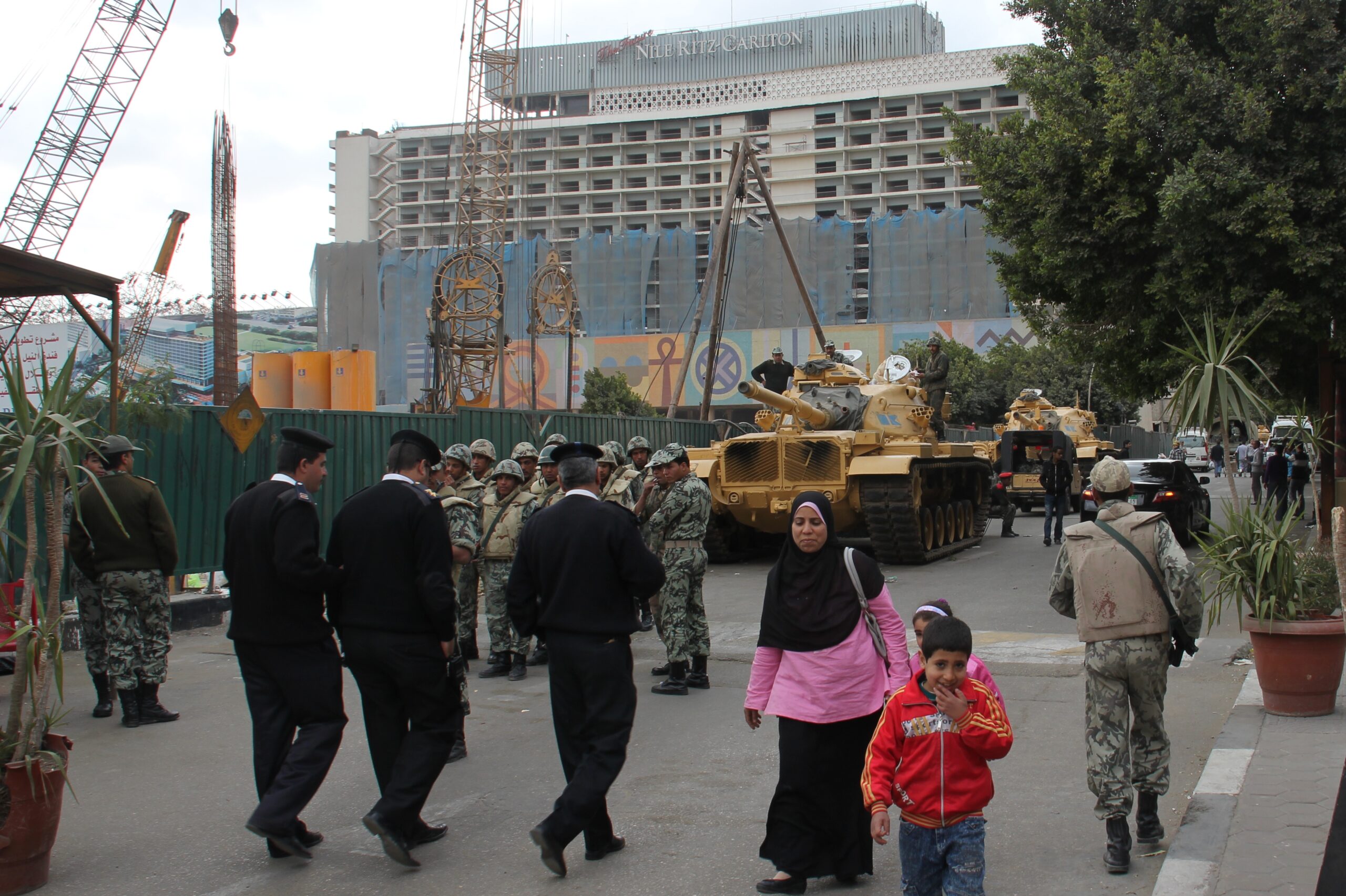
Soldiers and security officers walk near tanks outside Cairo’s Egyptian Museum.
A couple weeks later, however, the New York Times published an article suggesting that visiting the Land of the Pharaohs post-revolution is “like having a fast pass at Disney[land].” I phoned Quinn and directed her to the article, hinting that I might be interested in visiting Egypt despite the civil unrest. Quinn, an experienced traveler who has lived and worked in developing countries, is nothing if not adventurous. She agreed quickly to meet me in Cairo at the beginning of March.
A few days before my flight to Cairo via Casablanca, I began feeling anxious about the trip — feelings beyond my typical paralyzing angst over packing for a long trip across multiple climates and terrains. I sent an admission by e-mail to Quinn: “Full disclosure: I am a little nervous about going to Egypt.” But, I managed (barely) to pack two bags without slitting my wrists and slept for most of my flight to Morocco’s Mohammed V Airport. In Casablanca, I spent a couple days in a cheap hotel recovering from jet lag and wandering lost through the city’s busy streets, which, maddeningly, had almost no street signs.
Thankfully, I feel some of my fears subside when, after finally boarding my flight to Cairo, I realize that the passengers at my gate were readying to board a flight bound for a more conservative country in the Arabian Peninsula. I’m still the only white guy on my flight, but at least I’m one of many wearing jeans. When I land at the Cairo airport, I find Quinn waiting with a driver from our budget hotel.
“Is this your first trip to Egypt?” the driver asks. I tell him it is. “Welcome back,” he replies, nonsensically. Quinn tells me that, during my flight, a clash in Cairo’s Tahrir Square between camped-out protesters and Egyptian troops resulted in dozens of people injured. She also points out that a fight the previous day between Coptic Christians and Muslims in a Cairo suburb ended with 13 people dead. I add to the list a Tahrir Square demonstration the day before, in which a group of men attacked Egyptian women at an International Women’s Day rally.
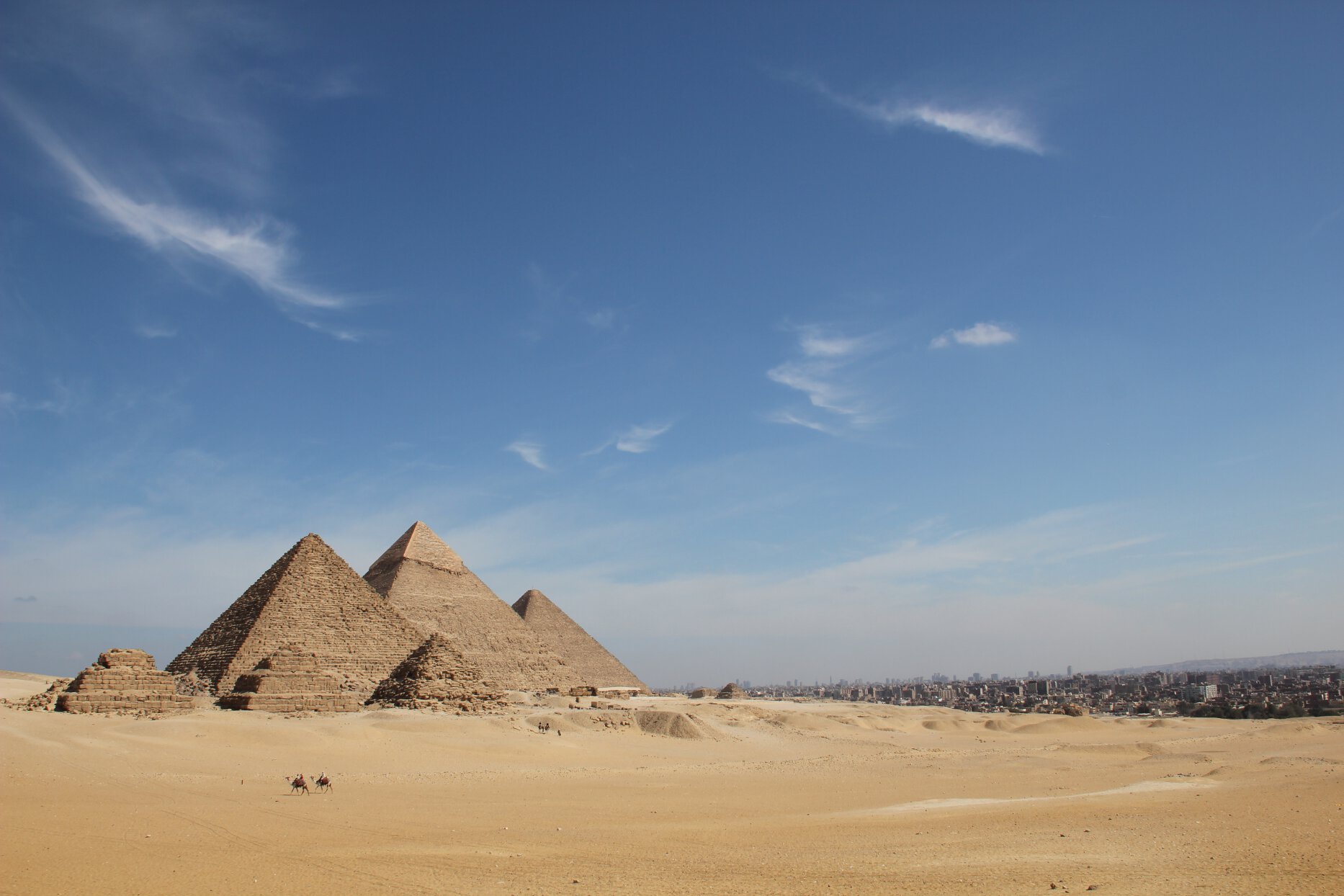
Men on camels ride near the Queen’s, Mycerinus, Chephren, and Cheops Pyramids outside Cairo.
“We really need to avoid all protests,” I tell her.
“But we might want to see one!” she says. I look at her uneasily.
“I don’t want to be killed here,” I say.
But, the next day, we walk from our hotel toward the Egyptian Museum, which, we discover, is adjacent to Tahrir Square, the Egyptian Revolution’s ground zero. We decide to take a quick walk through the Square, and we see a few hundred people milling about. Some people are holding protest signs; a few are selling T-shirts advertising the revolution; but most simply seem to be watching and waiting, as though they’re worried they might miss something exciting. Quinn and I, wearing typical Western dress, stand out in the crowd. A lot of people watch us as we take photos.
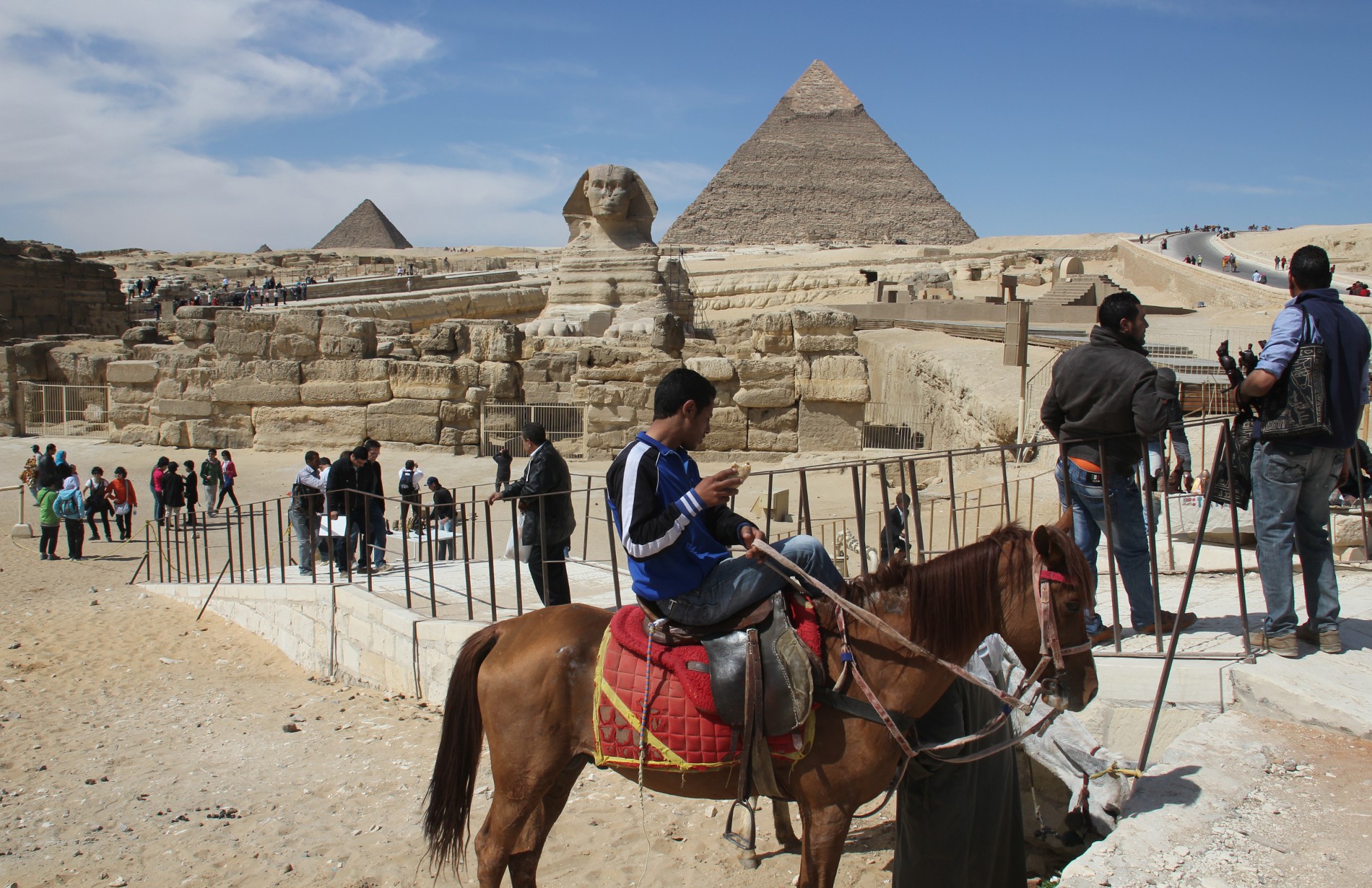
A man renting a horse waits for tourists in front of the Sphinx, the Chephren Pyramid, and the Mycerinus Pyramid.
“Welcome to the New Egypt!” an Egyptian college student blurts out as he approaches us. He tells us that his name is Mohammed, and when we tell him that we’re Americans, he asks, “Aren’t you scared?”
“No — we’re just excited to be here!” I tell him, surprising myself. I realize that I’m getting a rush just from feeling like I’m somehow physically standing on a pivotal point in history.
“Welcome back!” he responds. Of course, by now, we’ve heard the phrase used incorrectly many times by Egyptians. But, there’s something about the way Mohammed says it that makes me feel that, yes, we’re returning to something familiar. He seems so excited about the prospect of a democracy in New Egypt that maybe it makes sense that he’s welcoming us “back” — back to the world of potential social equality that we take for granted.
On the way to the Egyptian Museum, Quinn and I pass by swarms of soldiers and Egyptian military tanks guarding the entrance, undoubtedly to prevent any more incidents of looting and vandalism like those that occurred during the revolution. There’s no line to buy tickets or enter the museum, and once we’re inside, we see very few other people. We feel like we’re the only tourists in Egypt.
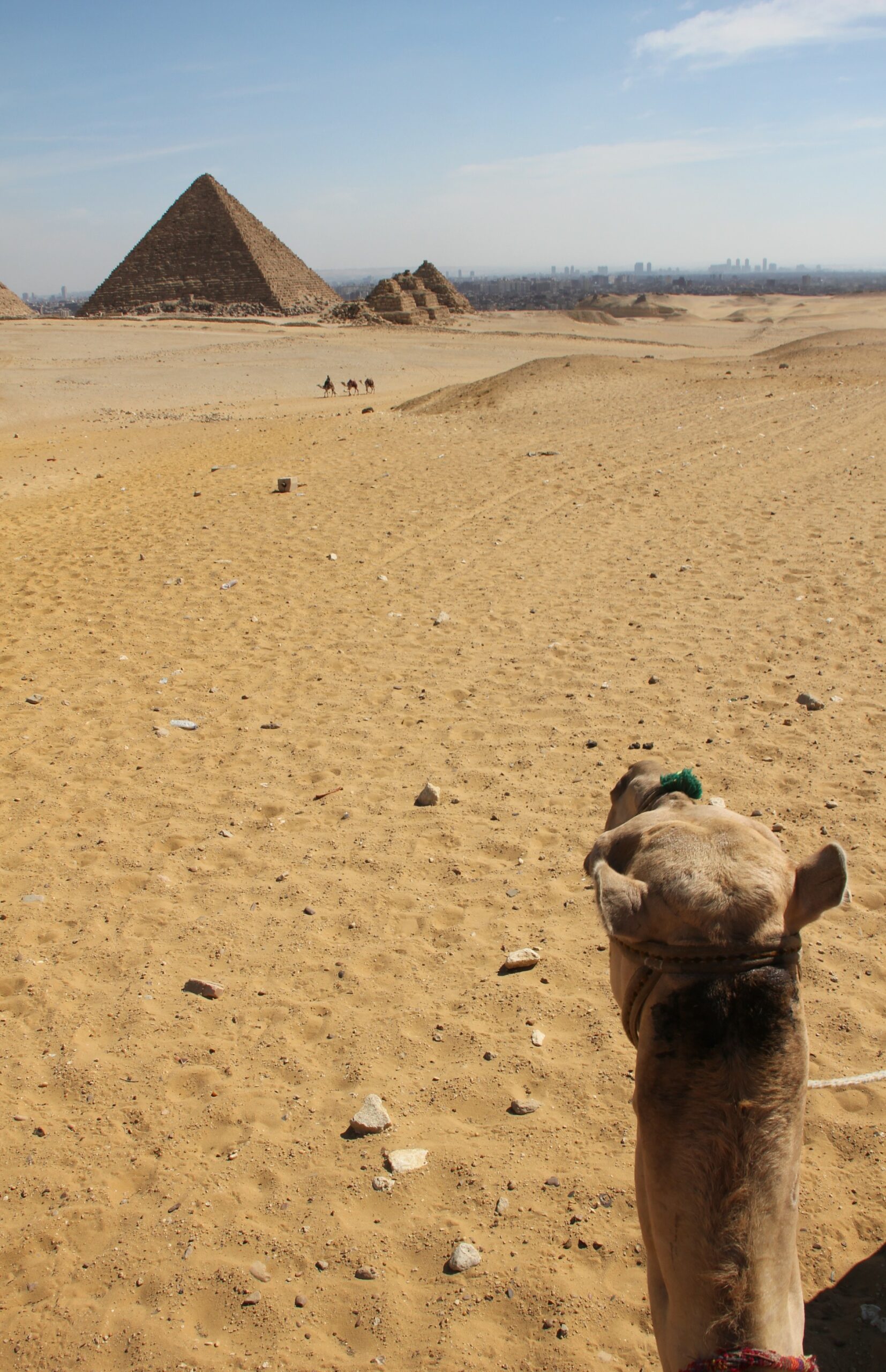
A camel walks toward the Pyramid of Mycerinus and the Queen’s Pyramids outside Cairo.
Though I’ve heard from others than the Egyptian Museum’s collection is unmatched, I’m still surprised by the place. Walking around the building feels more like we’re touring a clearance sale at Egyptian Relics Discount Warehouse than like we’re visiting a museum: the lighting is dim, items rarely have any accompanying written explanation, and each room is so crowded with fantastic artifacts that there’s barely room to move. Each relic is so exceptional that any given one seems like it could be any other museum’s most prized possession. We spend a couple hours marveling at rooms stacked to the ceiling with mummies, sarcophagi, and treasures from the tomb of King Tutankhamen.
The next day, we hire an Egyptian guide named Salma to take us to see the famous pyramids in Giza, Saqqara, and Dahshur.
“You are my first clients since 25 January,” she tells us. We realize that she hasn’t had work in almost two months. “We hope the tourists return to Egypt soon,” she says. When we ask her about the revolution, she tells us that she hopes that a new government will improve the country, though she admits that there’s a lot of uncertainty about the constitution and the future in general.
When we arrive at the Great Pyramid of Giza, we’re the only tourists there, except for a single group tour. The magnificent golden Pyramid’s tip touches the heavens, towering 450 feet above our heads. But, with so few people around to enjoy it, it looks lonely.
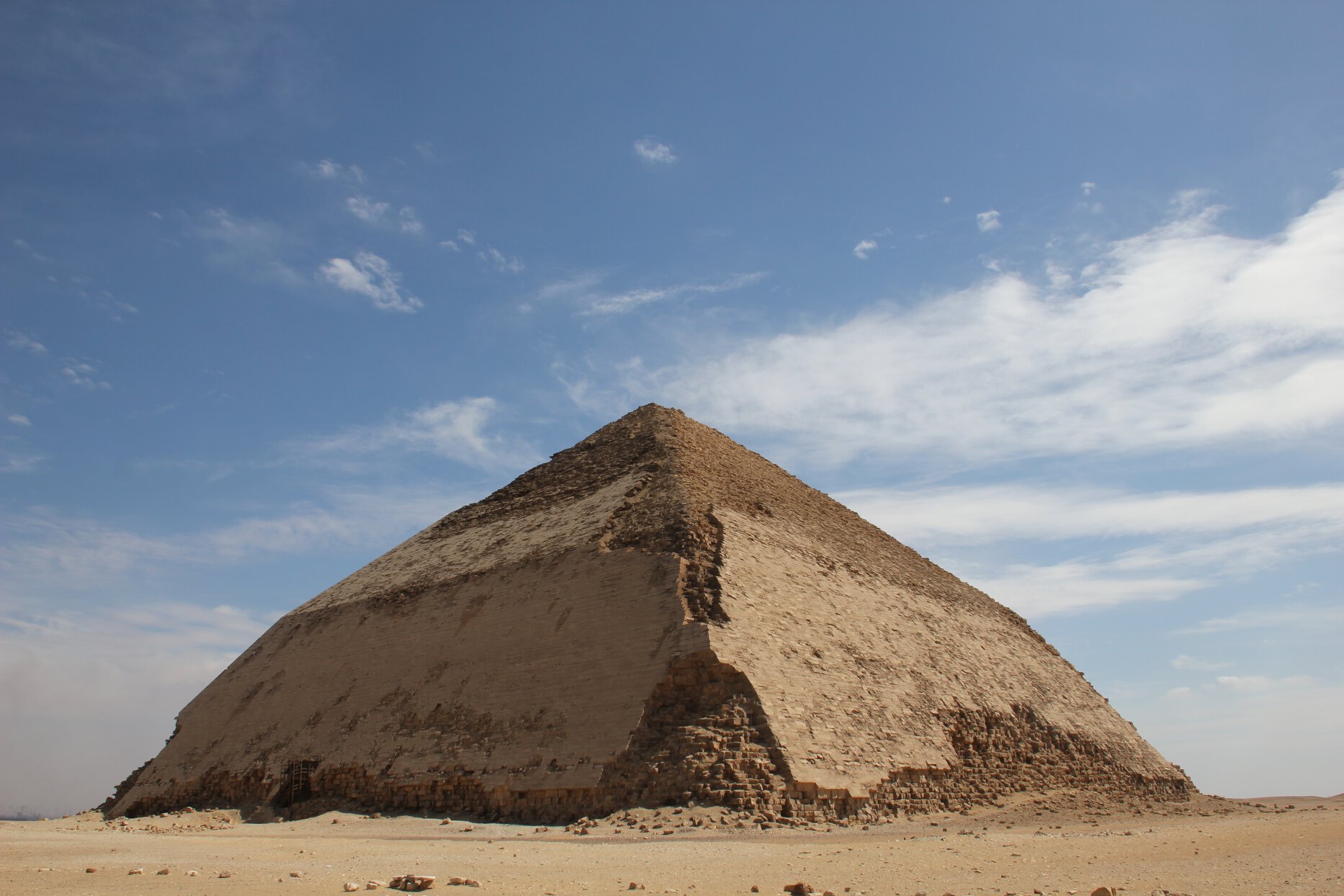
Not a single tourist can be seen in post-revolution Egypt at the Bent Pyramid in Dahshur.
Salma teaches us about some Egyptian history and then takes us to a ridge dotted with camels and their drivers, with a fantastic view of all of the Pyramids of Giza. One camel driver, wearing a thawb and a white turban, tells us that his name is Mohammed, and I begin to wonder whether every man in Egypt is named Mohammed or if it’s just that Egyptian men have an elaborate joke they play on tourists. He complains to us that the revolution has destroyed his business and begs us to take a ride at a rock-bottom price. As Quinn and I get ready to mount the camel, the driver looks at the two of us.
“Married?” he asks. We tell him that we are, because we’ve agreed in advance to tell all Egyptians this, partly at our guidebook’s suggestion. In an exceptionally conservative, Islamic culture like Egypt’s, it’s the easiest way to make sure others accept our traveling together.
“You a very lucky man,” he says, looking at Quinn’s blond hair. “I give you one million camels for her.”
Quinn chuckles as I pretend to consider the proposal, but his comment makes me realize that New Egypt isn’t totally new. It’s clear that antiquated conceptions about relationships and women are still deeply embedded in the culture, despite the revolution.
As Quinn and I ride our camel toward the Pyramids and Cairo skyline, it also occurs to me that there’s no way that I could get that many camels on a plane back to Los Angeles.
Shakira, Mohammed, and me
Seeing post-revolution Egypt’s most stunning pharaonic monuments without tourists.
MARCH 23, 2011 — On the way back from the Pyramids of Giza, our taxi driver, Mohammed (again!), takes Quinn and me through Tahrir Square. This time, it’s a Friday, and we see thousands of people gathered, holding megaphones, waving banners, and snapping cell phone photos. The demonstration looks peaceful, and our guide, Salma, tells us that the demonstrators want to make sure that Egypt’s interim martial leadership complies with the revolutionaries’ demands for a new government. It occurs to me that a revolution is not the final step in the hard work of building a new government, but, rather, the first step.
Quinn and I are starving when we wake up the next morning, and I suggest that we walk to a restaurant, The Egyptian Pancake House, which I’ve found in our guidebook (The Rough Guide to Egypt). Quinn is somewhat reluctant, because she prefers to find her own way instead of following guidebook recommendations. Nevertheless, we search through frenzied Islamic Cairo, weaving down the Muski — a narrow, congested street that looks like a Wal-Mart threw up on it, packed with frantic street vendors, discerning burka-wearing shoppers, and Arabic-signed storefronts. As we make our way into Cairo’s famous Khan el-Khalili bazaar, a British couple spots us. Western tourists are so rare in Egypt right now that they tend to recognize each other from a quarter-mile away and greet each other like old friends. The British couple is no exception; immediately they’ve agreed to join our increasingly-desperate search for fiteer (Egyptian “pancakes” made of layers of filo dough and butter).
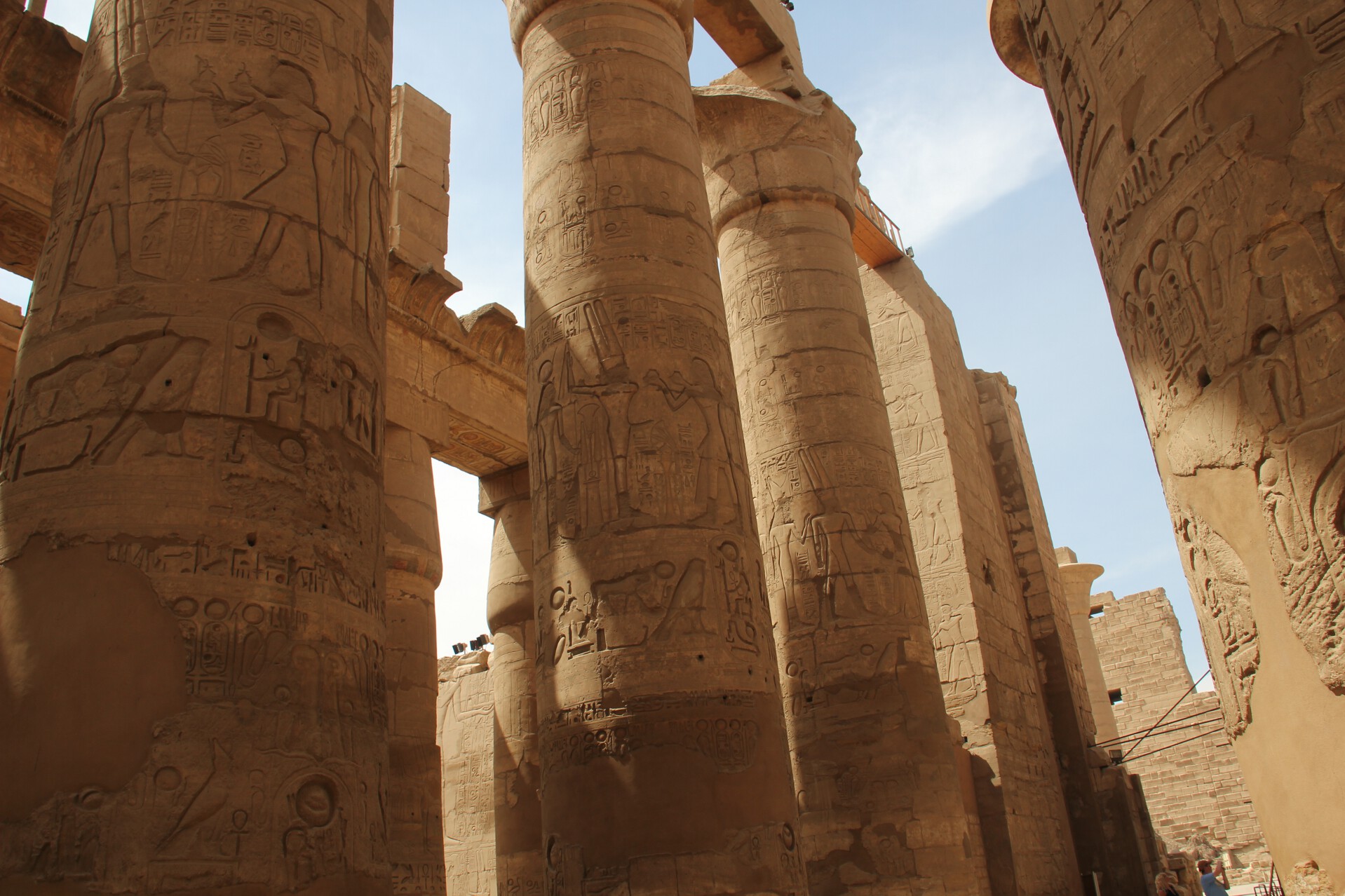
A carving depicts an Egyptian king making an offering to an erect Amun, the Egyptian god of fertility, in Karnak’s Great Hypostyle Hall.
As we walk, the ongoing maze of crowded streets becomes so complicated that my guidebook’s map becomes useless.
“Shakira!” vendors yell out to greet blond Quinn — who, objectively, looks almost nothing like blond, Colombian pop-star Shakira — as she walks by. Meanwhile, Egyptian men keep shouting, “You a very lucky man!” to me when they catch sight of Quinn. By the time we’ve realized the hopelessness of our quest, every tiny, clothing-filled alley looks the same as the one before, and we’ve been wandering for an hour and a half. During that time, I’ve been told how lucky I am to be “married” to Shakira at least fifteen times, which makes Quinn and I laugh over and over again. When I ask her if the attention bothers her, she tells me that, compared to places like India — and even the United States — she finds Egyptian men to be less threatening and more respectful toward her overall. I agree with her: despite the horror stories that I had heard about Western women traveling in the Middle East, I find Egyptians to be surprisingly respectful and warm toward both of us.
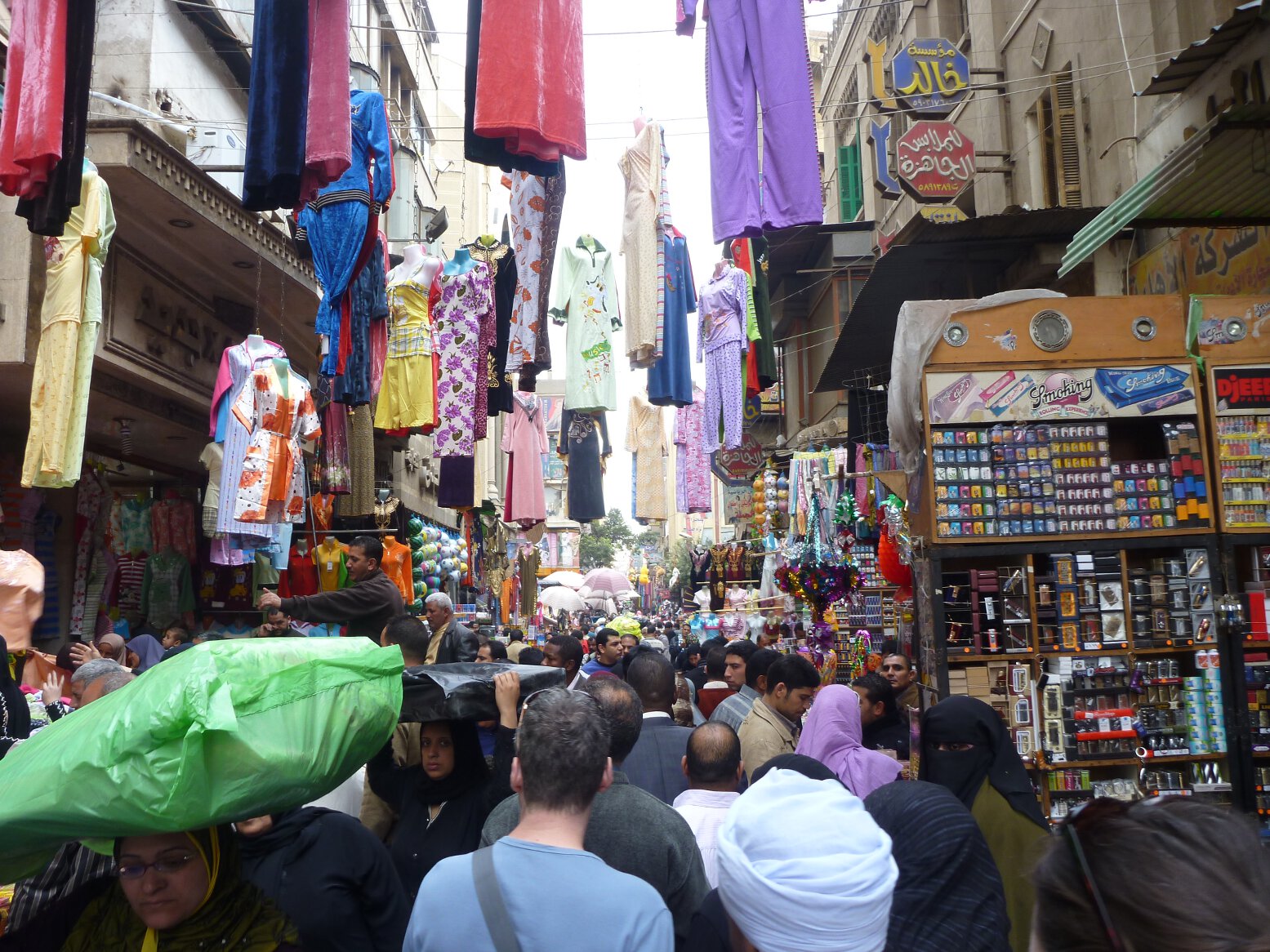
The Muski in Islamic Cairo is a street packed with vendors.
I’m so hungry that I announce that I want to stop and eat the next thing I see, which, unfortunately, turns out to be a man wearing a turban selling Egyptian rugs. Thankfully, by sheer luck, we stumble upon the upmarket, touristy Naguib Mahfouz Coffee Shop, which isn’t exactly the kind of place I like to go when visiting a foreign country. But, I’m embarrassed to admit that I’m so hungry that I’d eat at Applebee’s Islamic Cairo location, if such a sacrilegious thing existed. (Though that hypothetical menu would be fantastic, surely including bottomless falafel-flavored pomegranate margaritas, Jack-cheddar-smothered Egyptian mezzes in a zesty lime sauce, and beef-shawarma-stuffed Triple Chocolate Meltdown cake.)
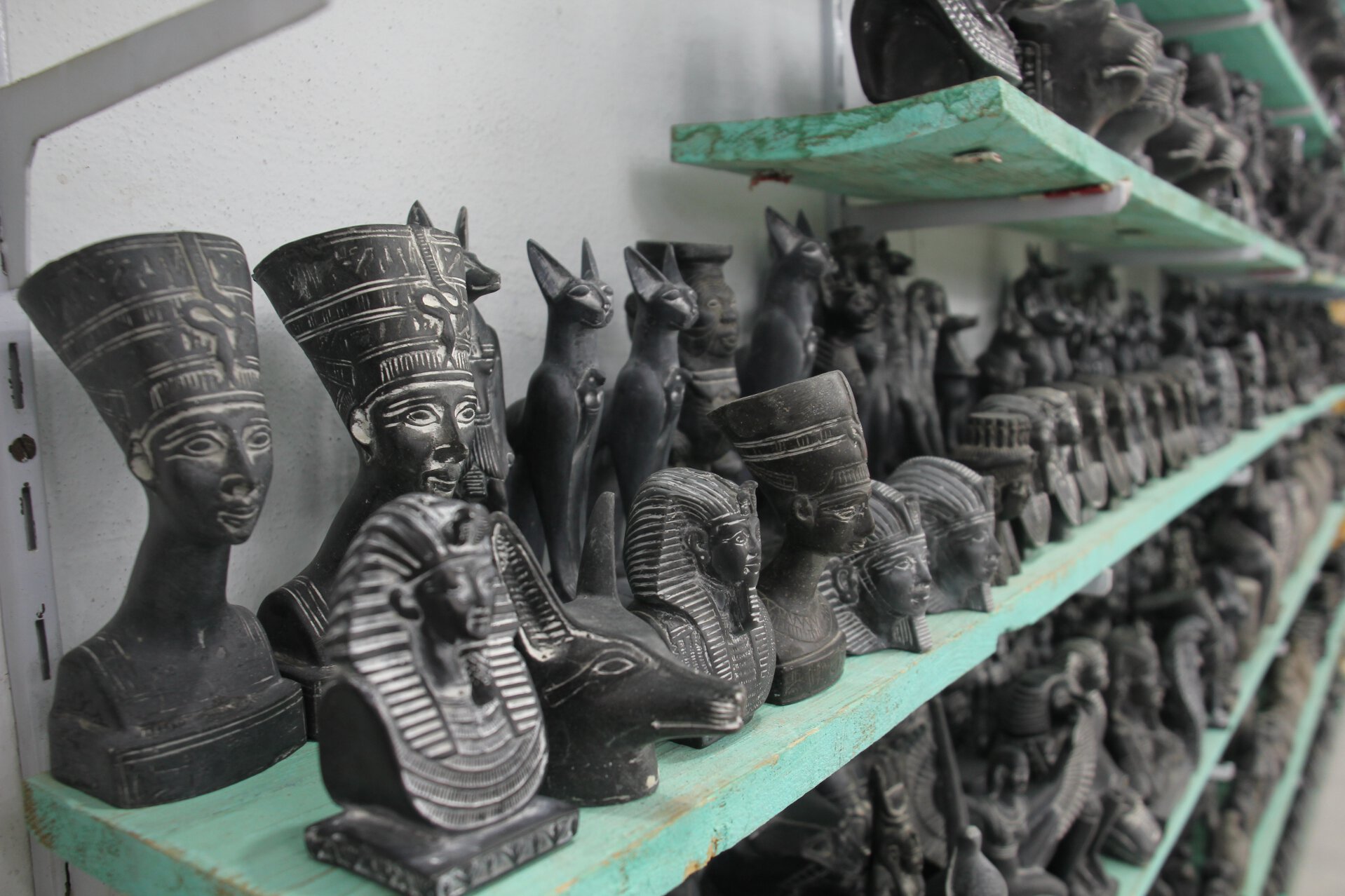
Onyx souvenirs sit on a shelf in an Egyptian gift shop.
After our meal, even though we’re no longer hungry, the British couple, Quinn, and I, inexplicably continue our obsessive search for fiteer, until we discover that the Egyptian Pancake House has been closed and replaced by a lone man who has placed a counterfeit “Egyptian Pancakes House” sign above a literal hole in a wall.
“This is why I hate guidebooks,” Quinn says. “We probably could have found fiteer a couple hours ago had we just started asking people where to find some.” It’s hard to disagree with her. Sometimes, I admit, pursuing the goal of eating at a specific Egyptian Pancake House overshadows what should be the real goal: stuffing one’s self with delicious fried bread filled with vanilla custard.
At the end of the day, after Quinn and I part from the Brits, we find a pastry vendor, named Mohammed (seriously!), selling basbousa — an Egyptian, honey-covered, filo dough dessert. After we buy (and eat) a half kilo, Mohammed then transforms himself into a de-facto tour guide, leading us to the roof of the nearby Blue Mosque. Quinn and I are the only people in sight when we climb to the top of one of the mosque’s minarets. As singing and chanting emanates from mosques citywide, Quinn and I watch the sunset, reflecting off the city’s famous Citadel on a hill, over post-revolution Cairo.
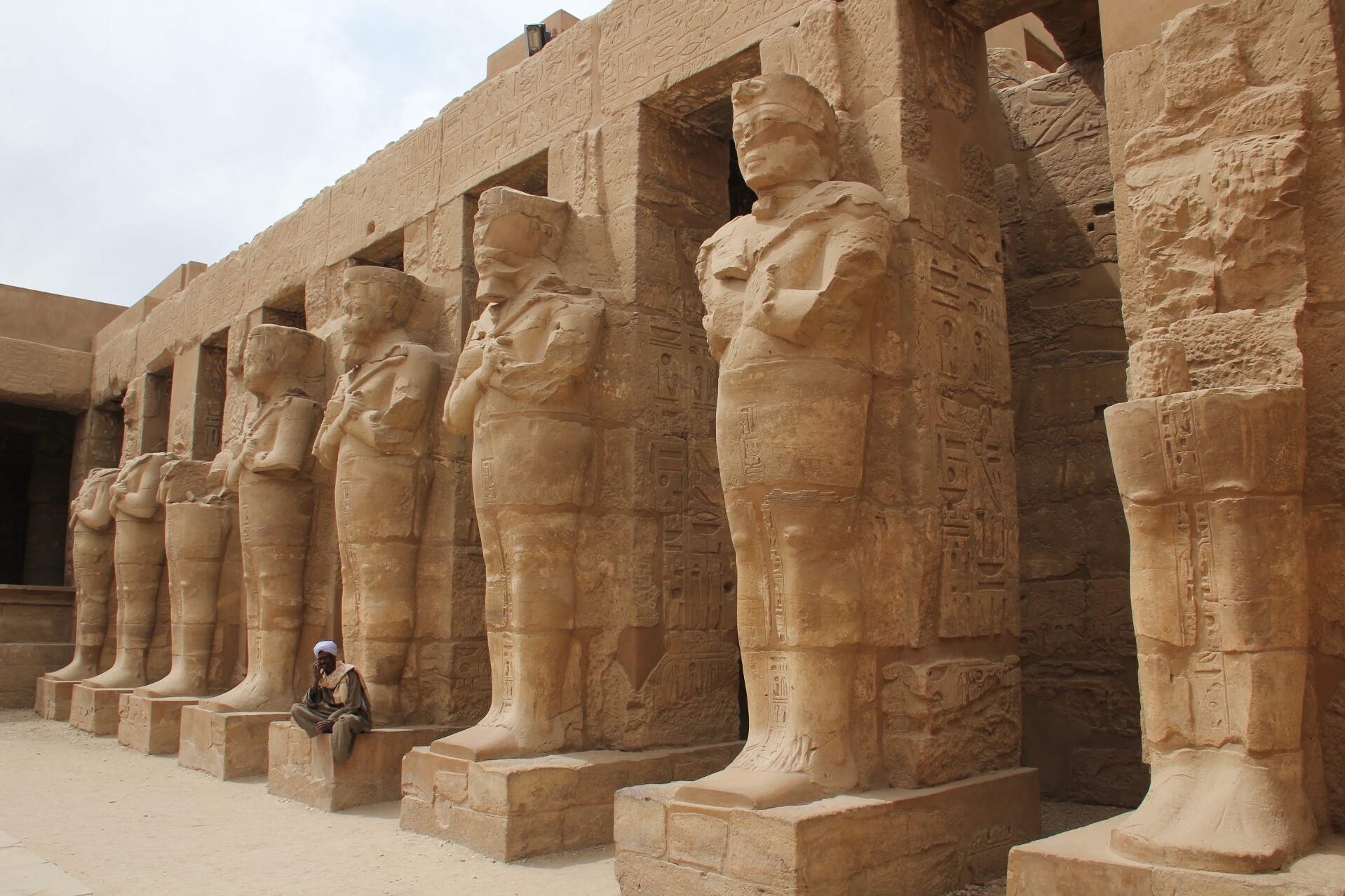
An Egyptian man sits in front of the Temple of Ramses III in Karnak’s Temple of Amun.
Quinn and I wake up at 6 AM the next morning to catch the 10-hour train to Luxor, home to the Theban Necropolis, a complex of gargantuan, ancient Egyptian mortuary temples and elaborate burial tombs. When we arrive, our first stop is the nearby Temple of Amun in Karnak, a titanic structure designed to house the Egyptian gods, big enough to contain ten great cathedrals. Many consider the site to be the single best pharaonic monument in Egypt, and we’re not disappointed. Almost devoid of tourists, Karnak’s dazzling Great Hypostyle Hall — a forest of 136 immense, orangey columns, some 75 feet high and 49 feet around — makes us feel like two tiny mortals who have wandered by mistake into an Egyptian god’s labyrinthine playhouse. As striking as the pillars themselves, the temple’s intricate and beautiful carvings depict the king making offers to the Egyptian god of fertility, Amun, whose enormous, carved erection is so surprising that I originally assume it to be graffiti until I read my guidebook aloud to Quinn: “Some Egyptologists believe that temple priestesses kept Amun happy by masturbating his idol, and that the pharaoh did his bit to ensure the fertility of Egypt by ejaculating into the Nile during the Optet festival.”
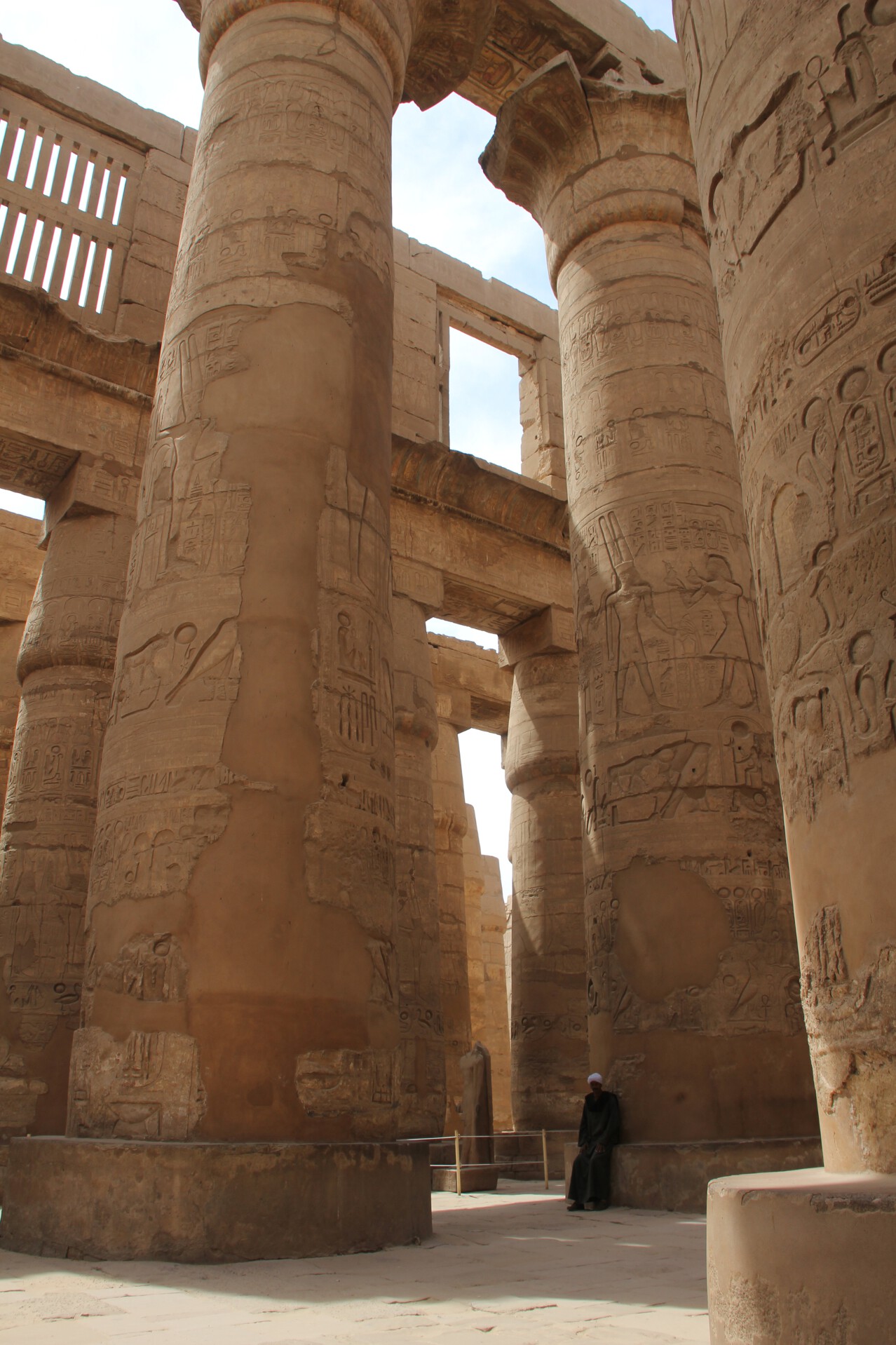
A guard keeps watch in the Temple of Amun’s Great Hypostyle Hall in Karnak.
“What does it really say?!” Quinn asks me after I read the passage, accusing me of inventing it.
“I can’t believe you think I would — or even could — make that up!” I reply, chuckling.
On our second day in Luxor, we hire a guide named Aladdin to take us to see the Theban Necropolis. When we learn that his daughter’s name is Jasmine, it takes all of our willpower to stop ourselves from asking whether his wife’s name is Jafar, and I realize that Western culture has warped us in strange ways.
Aladdin leads us past souvenir vendors (“Shakira!”/”You a very lucky man!”) on the way to see an collection of tombs in the Valley of the Queens and the Valley of the Kings. We’re so impressed by the tombs’ vivid hieroglyphics and intricate carvings that we can’t summon enough superlatives to adequately describe them.
Worried that the Pyramids didn’t manage to protect Old Kingdom pharaohs from tomb robbers, later rulers, like Ramses VI and the famous King Tutankhamun, chose to have their tombs built hidden deep under the ground in the Theban Hills’ boundless desert near the West Bank of the Nile. Quinn and I decide to visit King Tut’s tomb, and we’re the only two people inside as we descend into his burial chamber. When we see King Tut’s original mummy and catch a glimpse of the door to the tomb’s famous treasure room, we feel a small flicker of how archeologist Howard Carter and backer Lord Carnarvon must have felt when they discovered the tomb after five years of unsuccessful searching.
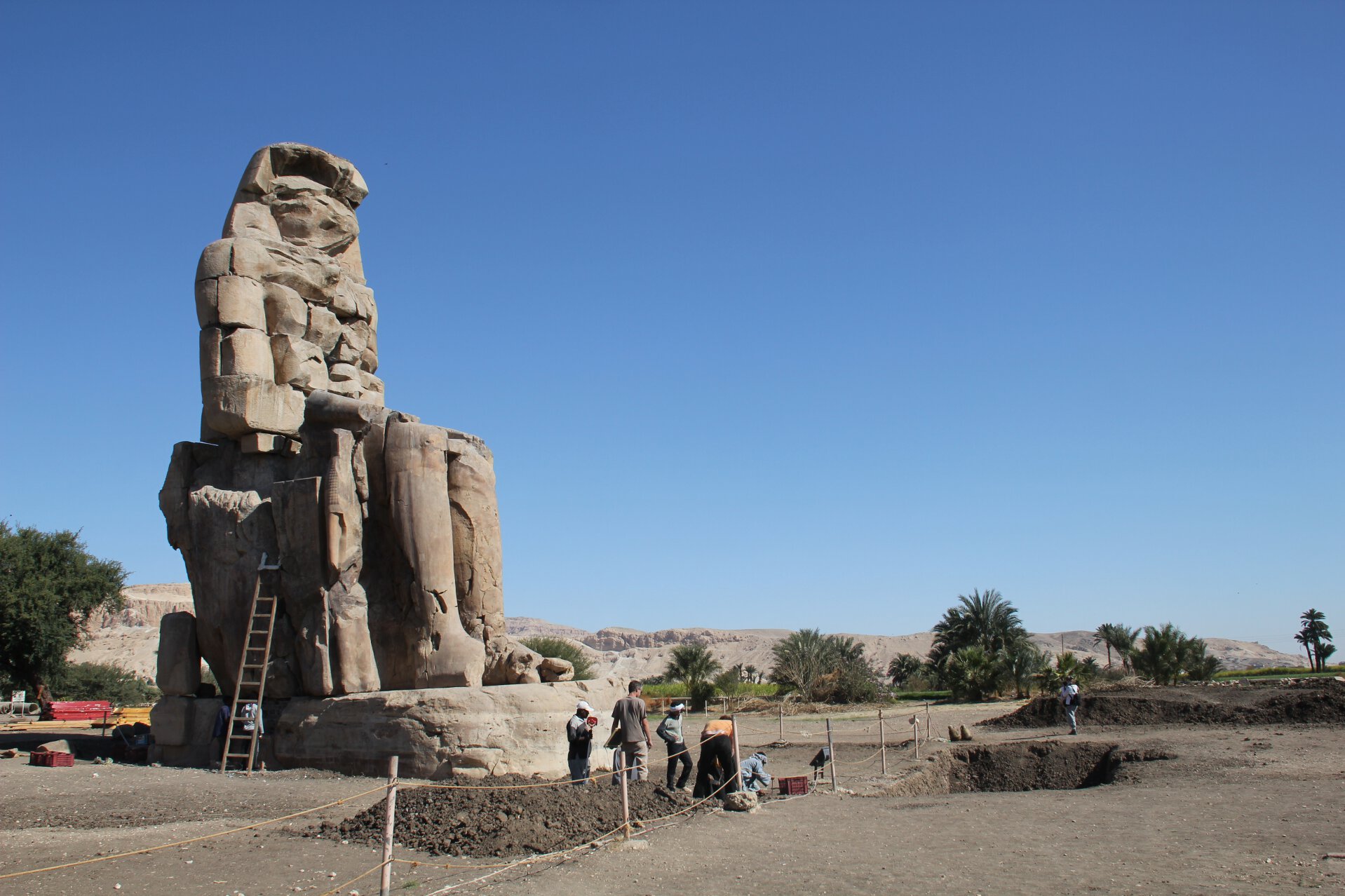
Restorationists work on one of the Colossi of Memnon at the entrance to the Theban Necropolis.
Most delicately beautiful, however, is the tomb of Ramses VI. Quinn and I stand in the burial chamber by ourselves, slowly running our eyes over the tomb’s beautiful art, astonished.
“I remember thinking that Egyptian history was one of the most boring subjects I had to learn about when I was in fifth grade,” I admit to Quinn. “If my boring teacher had taken us on a field trip here, I think I’d be a professional Egyptologist now.”
After our tour, Aladdin takes us to a handmade alabaster vase factory and store, where craftsmen demonstrate how they turn locally mined alabaster into attractive pots and vases.
“You a very lucky man,” the storeowner, named Mohammed (really!), says to me as he watches Quinn peruse the selection. “How many wives have you?”
“Just the one,” I say, continuing our marriage ruse designed to avoid awkward conversations.
“You should have four wives,” he says to me. “Though your wife is so beautiful maybe you only need the one.”
“That sounds complicated,” I say, not having any idea how to respond to compliments about the physical appearance of my fake wife. I’m not sure I’d even know how to respond compliments about the physical appearance of my real wife, if I had one. “How many wives do you have?” I ask.
“Two wives, but not so complicated,” he explains. “I spend a day with one and then a day with the other. But if you do have four wives, be sure to buy something for all of them when you buy something for one of them. That’s the complicated part.”

A felucca captain adjusts the sail on his boat on the Nile River at sunset.
“If I end up with four wives, I’ll keep that in mind,” I tell him. I file his marriage tip under “Lifestyle Tips I Will Never, Ever Need.”
In the evening, back in Luxor, Quinn and I decide to take a sunset cruise on the Nile in a felucca, a traditional Egyptian sailboat. Mohammed, our felucca captain, tells us that we’re his first clients since the revolution. He’s thrilled that we’ve hired him to take us out onto the river, and he’s more thrilled that it’s now legal to sail after sunset because Mubarak’s arbitrary and dictatorial policies have been erased. But Mohammed also tells us, grimly, that the tourist-dependent economy of Luxor is in trouble.
“I pray every day that the tourists return,” he says. “Do you think they’ll come back?”
“They will, very, very soon,” I assure him. But, I’m worried. Even with Mubarak’s resignation, the country is still far from having a new, democratically elected government, and Egypt’s tourist industry is essential to its economy. There’s a big part of me that loves Egypt without the tourists. But, as I’ve been told many times in Egypt, I’m a very lucky man. I know the sad reality of the lives of many Egyptians: if tourists don’t return to Egypt in droves soon, it will be difficult for them to survive.
Leaving a revolution behind
Saying goodbye as Egyptian revolutionaries protest on the eve of an important referendum.
MARCH 28, 2011 — At 6 AM on our last morning in Luxor, Quinn and I stand on the west bank of the Nile, watching as a group of Egyptian men inflate a large, colorful hot air balloon. We’re two of about fifteen tourists — the majority of the tourists currently in Luxor, I suspect — who have hired a company to float us above the temples and tombs of the Theban Necropolis.
Quinn and I can feel the heat from reddish-orange flames and hear the hissing sound of hot air being pumped into the balloon as we climb into the basket and the balloon begins lifting from the ground. The group emits a collective gasp as the balloon soars high enough for us to see the Nile River, cloaked in fog, flowing for hundreds of miles through the dry Egyptian landscape.
“Look,” Quinn whispers. She points at the dramatic shadow of our balloon, cast upon the rugged Theban Hills and the tomb entrances in the Valley of the Kings. I watch Quinn as we fly over the Ramesseum, and I see her eyes sparkle when she sees the Necropolis’s most dramatic megalith, the famous, 1000-ton, fallen colossus of Ramses II.
After about a half hour of imagining that I’m a flying Indiana Jones, our balloon lowers and glides over a woman wearing a chador, herding sheep near a field of sugar cane. We lightly touch down on the Nile’s west bank.
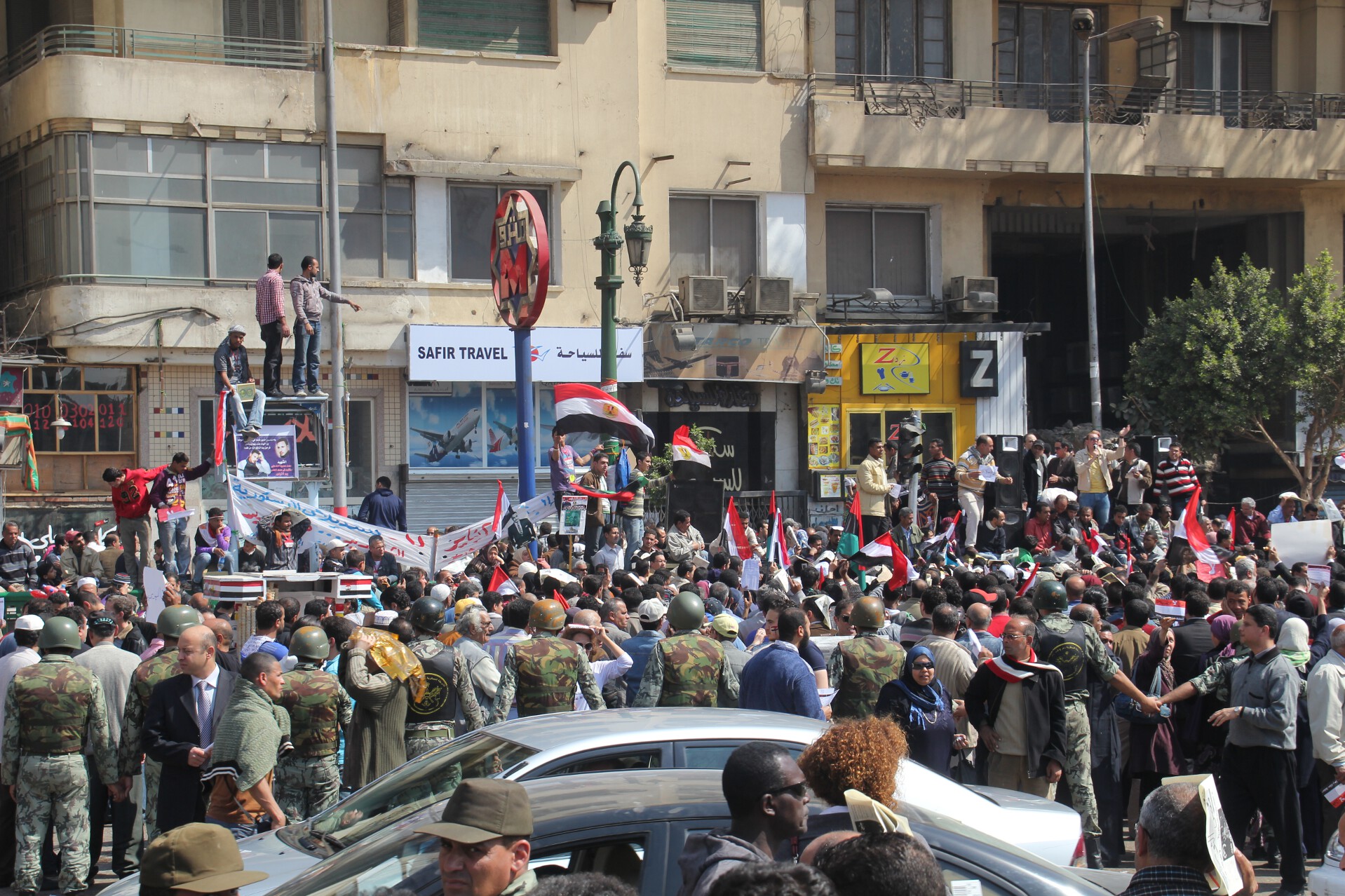
Protesters gather in Cairo’s Tahrir Square on the day before a controversial countrywide vote, organized by a military council, on constitutional amendments.
“Is it too late for us to become Egyptologists?” I ask Quinn. She smiles.
When Quinn and I return to Cairo, we take a taxi to visit the centuries-old Citadel, the most dramatic feature of the city’s skyline and the home of the impressive Mosque of Mohammed Ali. In the evening, we drop by the attractive Cairo Marriott, originally a guest palace built by Egyptian ruler Ismail the Magnificent. We have a drink together in the swish, outdoor cafe and then move to the hotel’s Egyptian restaurant to eat excellent mezze, a collection of small dishes including hummus, tahini, tabbouleh, and babaghanoush. We’re already overwhelmed by food when our waiter tops off our meal by bringing out fiteer with vanilla custard and molasses. We feel too full to eat more, but each of us still manages to take some bites. Finally, we have closure to the desperate search for excellent Egyptian pancakes that started on the second day of our trip.

A hot air balloon floats above the Theban Necropolis on the Nile’s west bank near Luxor, Egypt.
In our taxi on the way back to our hotel, we see an Egyptian man in the street handing out fliers written in Arabic. The man hands one to our taxi driver, who speaks surprisingly good English and, unbelievably, is named Mohammed.
“What does it say?” I ask him.
“Tomorrow there will be a demonstration in the Square about Saturday’s vote,” he tells us. He explains that the Egyptian military has asked citizens to vote on a set of proposed amendments to the constitution, but the revolutionaries insist that the constitution should be completely thrown out. “A new constitution should be written after a successful revolution,” he adds. “We fear that keeping our old constitution risks the creation of another dictator.” The revolution continues, I think.
Early the next morning, on our last day in Cairo, Quinn and I stand next to the taxi that will take her to the airport for her early flight. Our taxi driver, astonishingly, tells us that his name is Mohammed as he loads her bags into the car. Quinn and I look at each other.
“Thank you for a wonderful Egyptian adventure,” Quinn says.
“It was a once-in-a-lifetime trip,” I reply. “I’m glad I did it with you.” Then, for a moment, we forget that we’re standing in full view on the street in a country in which public displays of affection are taboo. We kiss.
Then, Quinn gets into the taxi, and, as if on cue, Mohammed says to me, “You a very lucky man.” I watch Quinn through the window as Mohammed begins driving toward the airport. Even as she smiles and waves at me, she somehow manages to look sad. I imagine that I look the same to her.
Not exactly sure what to do with myself in Cairo without Quinn while I wait for my afternoon flight, I take a quick stroll around the city’s scenic Al-Azhar Park. I watch kids playing on lawns and listen to midday prayers wafting over the city from mosques. Then, an hour before I need to leave for the airport, I decide to walk to Tahrir Square one last time. On the way, I stop to grab some beef shawarma and falafel from GAD, a hectic, fast food Egyptian restaurant that Quinn and I fell in love with during our time in Cairo. I already find myself missing her. I’m still munching on my Egyptian bread when I arrive in Tahrir and see thousands of demonstrators filling the Square. They’re holding banners written in Arabic, waving flags, and chanting. Vendors are selling revolution T-shirts, bumper stickers, and hats. Because of the lack of tourists, it’s clear that the vendors selling revolution-themed goods are doing so not for sightseers, but for the demonstrators. This revolution has a gift shop.
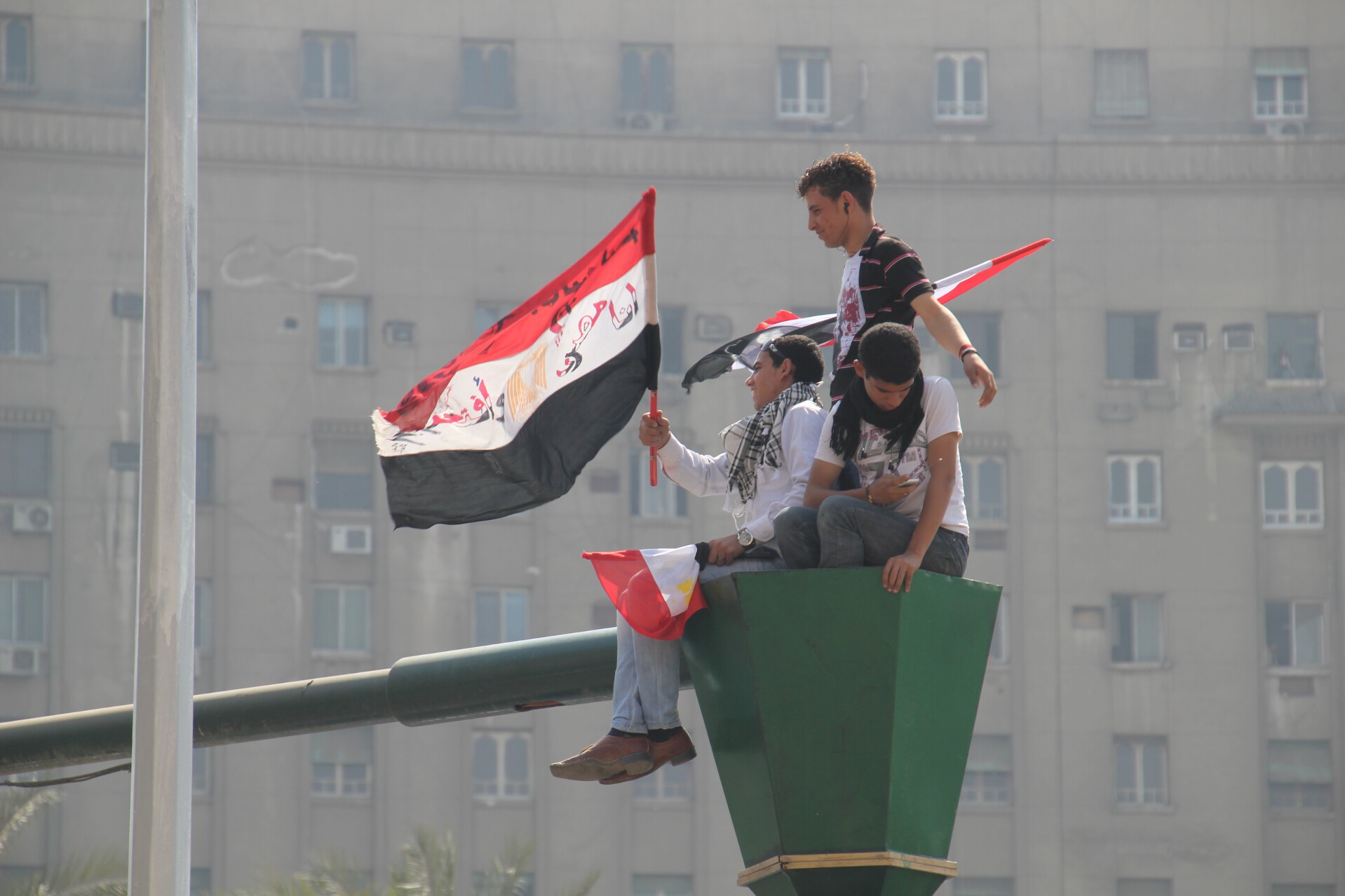
Teenagers wave a flag above Cairo’s Tahrir Square on the day before a countrywide vote on constitutional amendments.
As I’m leaving, I strike up a conversation with an Egyptian woman, Shahd, who tells me that she was in Cairo from the revolution’s beginning. She says that though she was scared for the first two days, the revolution’s tone eventually became upbeat.
“People sold popcorn, candy, and souvenirs, and it felt like a party,” she says. “Now, I am hopeful for the future, but I’m afraid that creating a new, democratic government will be difficult.” When I ask her what she thinks about the next day’s vote on constitutional amendments, she tells me that she thinks it’s essential that Egyptians vote against the amendments and stay committed to writing a completely new constitution. She says that she is terrified that the Muslim Brotherhood — a conservative Islamic political group that is the country’s most well-organized political party and has been linked to the Egyptian military — will garner enough votes to gain power and create an Islamic government. She says that it’s important for the revolutionaries to learn how to organize themselves better, in order to ensure progress for Egyptian women and for the country as a whole.
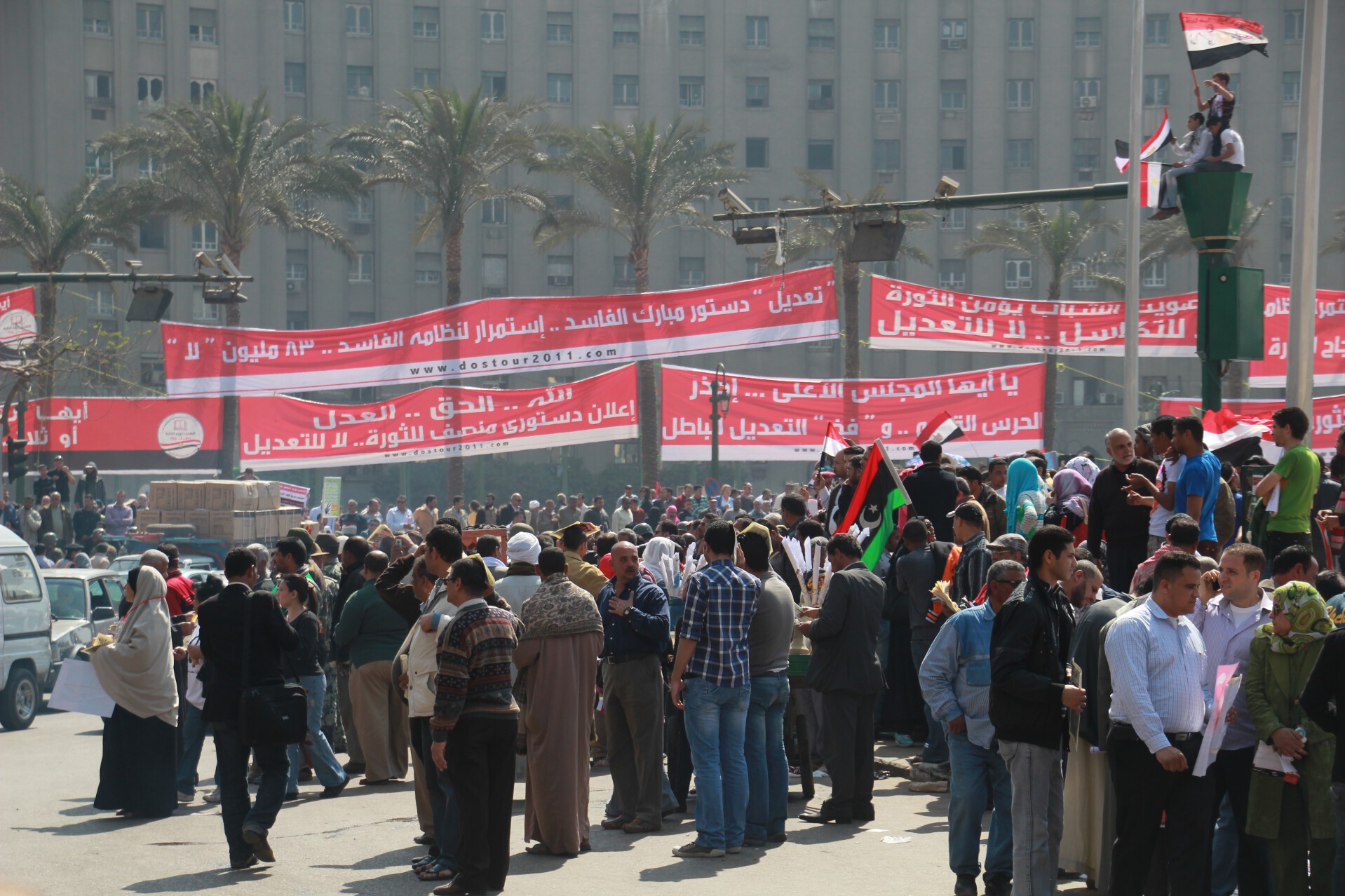
Protesters hold banners in Cairo’s Tahrir Square on the day before a countrywide vote on constitutional amendments.
On the day after the referendum, while sitting in a hotel in Casablanca, Morocco, I read a New York Times article, which reports that 77 percent of Egyptian voters (with a 41 percent turnout) approved eight constitutional amendments, all designed to lay the groundwork for rapid elections. As Shahd predicted, the country’s revolutionaries were pushed aside by the well-organized supporters of the referendum: The National Democratic Party (the remnants of previous President Hosni Mubarak’s supporters) and the Muslim Brotherhood.
I think of the people I met in Egypt: Shahd, the woman I met as I was leaving; the taxi driver who grabbed a protest flier while taking Quinn and me to our hotel; Salma, our tour guide; and Mohammed, the young student in Tahrir Square who welcomed me to the “New Egypt” when I arrived. I worry that their worst fears — and those of millions of other young Egypt revolutionaries — are coming true. I worry that the “New Egypt” won’t be novel for long.
How to Visit Tahrir Square and the New, Post-Revolution Egypt
OVERVIEW: Though previous Egyptian President Hosni Mubarak resigned on February 11, demonstrations continue (usually on Fridays) throughout Egypt and the US State Department continues to urge citizens to defer non-essential travel to the country. With that in mind, it’s mostly business as usual in Egypt now — except that travelers can get great deals on hotels and tourist services due to the current lack of demand. Also, you won’t find yourself standing in line for anything.
LOGISTICS: Fly to Cairo International Airport and take a taxi into the city (£E60/US$10). (Most hotels — even budget ones — will pick you up from the airport for a fee when asked, if you wish to avoid haggling with taxi drivers.) Cairo has a wide range of hotels. The Cairo Marriot (originally a guest palace built by Egyptian ruler Ismail the Magnificent, it has a swish outdoor cafe and tasty Egyptian restaurant), Conrad Cairo, and Four Seasons are all excellent luxury options. We stayed near Tahrir Square in the more budget-conscious, historic Hotel Windsor; after we haggled a bit, they gave us 50% off their listed rates due to slow business. The hotel’s antique elevator and vintage decor give it a classic (albeit dated) feel. The staff pushes hard to convince guests to buy tour packages, but they gave us a good price and decent English-speaking guide for our day tour of the Pyramids. The Lialy Hostel, Lotus Hotel, Hotel Osiris are even cheaper options.
VISITING TAHRIR SQUARE: Any taxi driver can take you to Tahrir Square, though many hotels in Cairo are within walking distance of the Square (and the Egyptian Museum). To be extra careful, you may want to avoid visiting Tahrir on Fridays, which is when demonstrations continue to occur.
VISITING THE PYRAMIDS: Any hotel will happily arrange for a driver and an English-speaking guide (US$30 per person) to tour the pyramids at Giza (£E60/US$10 for the entrance ticket and an additional £E100/US$17 to go inside Cheops), Saqqara (£E60/US$10), and Dahshur (£E30/US$5). Those wishing to skip the guide can simply hire a taxi for the day (£E200/US$34). Fewer people visit the Pyramids at Dahshur, though we saw no other tourists at Saqqara and Darshur when we visited and very few people even at Giza.
How to See Karnak and the Theban Necropolis near Luxor, Egypt
OVERVIEW: Though previous Egyptian President Hosni Mubarak resigned on February 11, demonstrations continue (usually on Fridays) throughout Egypt and the US State Department continues to urge citizens to defer non-essential travel to the country. With that in mind, it’s mostly business as usual in Egypt now — except that travelers can get great deals on hotels and tourist services due to the current lack of demand. Also, you won’t find yourself standing in line for anything.
LOGISTICS: Fly directly to Luxor International Airport from Cairo or most major Western European cities. Or, take a taxi to the Cairo’s Ramses Train Station and take the 10-hour train ride to Luxor. Overnight one-way tickets in a sleeping compartment cost US $60, but standard express train service costs significantly less. Ticket vendors tell tourists that they can’t take the day trains to steer them toward the more expensive sleeper train, but a hotel (or even the tourist police at the station, we heard) will buy tickets for you if you ask. Another useful strategy is to board the train and buy a ticket directly from the conductor when he asks for your ticket, paying a miniscule penalty fee. Luxor is a major tourist destination, so it has a broad selection of hotels. The beautiful Sofitel Winter Place is a great luxury choice. We stayed in the budget-conscious Princess Hotel, which gave us our own bathroom and hot shower for only US $10 per night. The desk staff isn’t pushy but is happy to help you organize tours and willing to negotiate good deals.
VISITING KARNAK: Do not miss the Temple of Amun at Karnak (£E30/US $11) — it won’t disappoint. The easiest way to visit the Temple is by taking a taxi from Luxor (£E30/US $5 round trip including 2 hours of wait time). It’s also possible to catch a local minibus on the road next to the Nile. You may want to spend a long time lingering in the Great Hypostyle Hall — I recommend bringing a book and simply relaxing amidst the grandeur of ancient Egypt.
VISITING THE THEBAN NECROPOLIS: The Theban Necropolis is a must-see, but the number of sights is overwhelming. Try seeing the Tombs of the Nobles, Deir el-Bahri, and Medinet Habu on one day; then on a second day treat yourself to an impressive finale by seeing the best sites: the tombs in the Valley of the Queens and Kings (the Ramses VI tomb is spectacular) and the Ramesseum. Visiting any given site (including each individual tomb) costs an average of about £E20/US $3, so don’t expect to see every tomb unless you want to spend a lot of money and have an unnatural penchant for burial chambers. There’s no reason that you can’t do this by yourself by renting a bicycle (£E10/US $1.50 per day) after taking a cheap ferry (£E1/15 US cents) to the Nile’s West Bank (recommended) or a private taxi (£E20/US $3 per hour), but you may find that hiring a guide and driver makes the experience easier, less stressful, and more educational. Finally, the sites are close enough together that fit travelers may want to visit the Necropolis on foot. For the mildly adventurous, it is possible to take a half hour hike over the hills between the Deir el-Bahri and the Valley of the Kings, despite the sign and guard telling you that doing so is prohibited.
How to Fly in a Hot Air Balloon Over the Theban Necropolis near Luxor, Egypt
OVERVIEW: Though previous Egyptian President Hosni Mubarak resigned on February 11, demonstrations continue (usually on Fridays) throughout Egypt and the US State Department continues to urge citizens to defer non-essential travel to the country. With that in mind, it’s mostly business as usual in Egypt now — except that travelers can get great deals on hotels and tourist services due to the current lack of demand. Also, you won’t find yourself standing in line for anything.
LOGISTICS: Fly directly to Luxor International Airport from Cairo or most major Western European cities. Or, take a taxi to the Cairo’s Ramses Train Station and take the 10-hour train ride to Luxor. Overnight one-way tickets in a sleeping compartment cost US $60, but standard express train service costs significantly less. Ticket vendors tell tourists that they can’t take the day trains to steer them toward the more expensive sleeper train, but a hotel (or even the tourist police at the station, we heard) will buy tickets for you if you ask. Another useful strategy is to board the train and buy a ticket directly from the conductor when he asks for your ticket, paying a miniscule penalty fee. Luxor is a major tourist destination, so it has a broad selection of hotels. The beautiful Sofitel Winter Place is a great luxury choice. We stayed in the budget-conscious Princess Hotel, which gave us our own bathroom and hot shower for only US $10 per night. The desk staff isn’t pushy but is happy to help you organize tours and willing to negotiate good deals.
FLYING OVER THE THEBAN NECROPOLIS: Any hotel will happily help you arrange for a hot air balloon flight over the Necropolis, but be sure to shop around and haggle a bit with whoever quotes you a price. There are plenty of tourist agencies selling balloon rides on the road along the Nile near the Sofitel Winter Palace. For our trip, we paid about $70 per person, which our hotel arranged for us after some bargaining. It’s worth waking up early to take the flight at sunrise. The hot air balloon company should arrange a driver to take you to the edge of the Nile and then across the river on a boat. On the other side, you’ll be driven to a balloon staging area where you’ll jump in the basket and take the flight.
i bet it feels like hundreds of years ago, at the pyramids – without all the tourists! what an amazing story.
I can't believe you were in Egypt for all of this! I mean it's amazing that you got to be an eye witness to the post-revolution process, but part of me also wants to wag my finger at you like a worried mother. It's a good thing you are "a very lucky man."
Also, I would very much like to eat some fiteer and mezze. But not at an Egyptian Applebee's.